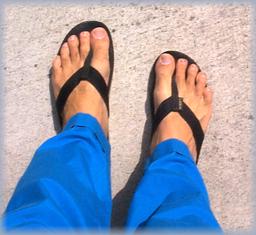ZORI are a type of traditional Japanese footwear. The modern
version is sometimes referred to as slippers, sandals, thongs, or flip-flops. In
Hawai`i, they are most commonly called "slippahs" or zori.
I think they are the most comfortable, convenient, and versatile shoes on the planet.
Zori can get wet with no problems and dry rapidly. They let your feet breathe
naturally. Conventional shoes bind you, crushing the toes together, warping the
shape of your feet, trapping moisture in place leading to unhealthy foot conditions.
Zori are healthy, lightweight, and inexpensive.
I've worn them my entire life, except for public school which had rules against
open-toe footwear. My parents have worn them for most of their lives as well.
I've done everything in them, even playing football and hiking through snow.
Technically, Zori are "a thin or thick soled sandal with a V-shaped thong which
comes between the big toe and the rest of the foot and so keeps the sandal in place."
Traditionally made of straw, modern zori are made of rubber, with plastic or nylon
straps. Old-fashioned styles often meant to have the thong go
between 2nd and third toes, unlike more comfortable modern style.
Japanese footwear was designed so that it is easy to slip off, necessary in a country
where footwear is removed before entering a house.
Where to find them: In stores, the most reliable source is "Surf" and
"Sport" shops. I can highly recommend
the "Scott" brand as being
very study and reliable, and their website allows direct ordering.
Insist on proper arch support! My favorite Scott style is the "Hokulea".
There are a bunch of "official" Scott dealers online, but for many years
i have happily ordered from a nice site called "International
Marketing Group".
In the early 1990s, a company called "Teva" figured out that if you take a
modern zori, add a few more straps and charge a ridiculous amount of money, then yuppies
would buy them in droves.
All seasons: Many people are surprised to see me wearing my zori
in cold weather. I find that once you become acclimated, your feet
are no more temperature-sensitive than your hands! Hence, you don't
need socks until you also need gloves. So if the weather gets cold,
or you need to "dress up" for formal settings, you need:
Toe socks: Called tabi in Japan, these are
special socks that have a gap in the toes. Around the world, they
are popular as a "fun" sock for children, but also are available in
"serious" styles for men and women.
(As tabi, toe socks are popular
in the martial arts. However, ninja wouldn't wear zori since the flapping sound
could give away their presence - instead, they wore special tabi with extra thick
soles built into the socks.)
Warm toe socks can be hard to find. I finally found
some at Olas Sol Socks.
Strange fact: Great toe transplantation is the process of surgically
moving a big toe to your hand, to replace a missing thumb. It is "not popular
in the Orient, where zori-type sandals, which require a first web space, are worn."
Feedback from Habib in New York: "The
sandals I've owned so far were all from the Reef
Brazil brand. I like them. Unfortunately, I work for a bank which forces
me to wear suits, ties and conventional shoes on the premises."
June 2006, NY Times article says:
Suddenly, flip-flops — those slabs of rubber with V-shaped slivers between
the toes — are ubiquitous in what were once dressed-up settings.



thanks to mantid for help with the zori info!